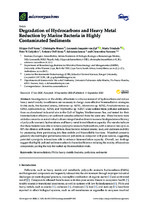| dc.contributor.author | Van Zyl, Leonardo Joaquim | |
| dc.contributor.author | Dell’Anno, Filippo | |
| dc.contributor.author | Brunet, Christophe | |
| dc.date.accessioned | 2020-12-15T10:45:23Z | |
| dc.date.available | 2020-12-15T10:45:23Z | |
| dc.date.issued | 2020 | |
| dc.identifier.citation | Van Zyl, L. J. et al. (2020). Degradation of hydrocarbons and heavy metal reduction by marine bacteria in highly contaminated sediments. Microorganisms 8(9),1402, 1-18 | en_US |
| dc.identifier.issn | 2076-2607 | |
| dc.identifier.uri | https://doi.org/10.3390/microorganisms8091402 | |
| dc.identifier.uri | http://hdl.handle.net/10566/5521 | |
| dc.description.abstract | Investigations on the ability of bacteria to enhance removal of hydrocarbons and reduce heavy metal toxicity in sediments are necessary to design more effective bioremediation strategies. In this study, five bacterial strains, Halomonas sp. SZN1, Alcanivorax sp. SZN2, Pseudoalteromonas sp. SZN3, Epibacterium sp. SZN4, and Virgibacillus sp. SZN7, were isolated from polluted sediments from an abandoned industrial site in the Gulf of Naples, Mediterranean Sea, and tested for their bioremediation efficiency on sediment samples collected from the same site. These bacteria were added as consortia or as individual cultures into polluted sediments to assess biodegradation efficiency of polycyclic aromatic hydrocarbons and heavy metal immobilisation capacity. Our results indicate that these bacteria were able to remove polycyclic aromatic hydrocarbons, with a removal rate up to ca. 80% for dibenzo-anthracene. | en_US |
| dc.language.iso | en | en_US |
| dc.publisher | MDPI | en_US |
| dc.subject | Bioremediation | en_US |
| dc.subject | Heavy metals | en_US |
| dc.subject | Bacteria | en_US |
| dc.subject | Sediments | en_US |
| dc.subject | Pollution | en_US |
| dc.title | Degradation of hydrocarbons and heavy metal reduction by marine bacteria in highly contaminated sediments | en_US |
| dc.type | Article | en_US |

